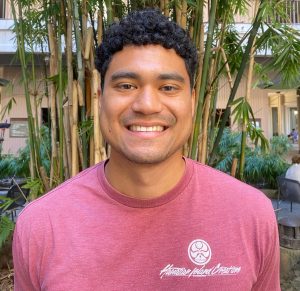
Historic Map Collection At UH Is An Underused Community Treasure
Improving access to archival maps can help students picture history鈥檚 greatest adventures and ignite curiosity about cultures and languages.
Improving access to archival maps can help students picture history鈥檚 greatest adventures and ignite curiosity about cultures and languages.
The route of , a bird鈥檚 eye view of in Japan and a rare image showing a of Manchuria are all represented in a newly available online map collection from the University of Hawaii Manoa.
These maps represent just a fraction of the 200,000 maps held in the UH collection, but they also are a growing part of the digitization efforts being stressed at the university, said Ted Kwok, a geospatial librarian who manages the collection.
They are underused community treasures, Kwok said, just waiting for UH to digitize them and for people to have access to them online. The potential audience for these maps is much greater than the small group of students willing to get the proper permissions to get close, don white gloves and enter the climate-controlled rooms where visitors can examine or even sometimes handle the pieces, he said.

鈥淯ndergraduates, graduate students and researchers alike find it very hard to access and find these materials,鈥� Kwok said, 鈥渨hich is why it is important to acquire them and make them accessible.鈥�
A map could be worth hundreds or thousands of dollars but could feel invaluable to viewers and academic researchers.
For example, UH has a 1606 map of that includes Korea as an island, plus three principal islands of Japan and a part of China. Mapmaker Jodocus Hondius was not sure whether Korea was an island or part of the mainland at that time, giving a sense of how mysterious this area of the world was to outsiders. In the unknown or white spaces, Hondius added flourishes such as sea monsters, a Japanese junk vessel and a Dutch galleon.聽
There is no formal budget for the digitization and preservation of the maps, Kwok said, so the library can’t digitize them consistently or at high volume.聽
Each map must go through a process much like cars go through on an assembly line, Kwok said. After a map is brought in, it goes through an assessment to see what needs to be done before it can be digitized.聽
鈥淧reparing a map for digitization is all about making sure that the condition is stable enough so that it won鈥檛 get damaged during that process,鈥� said Liane Na驶auao, a preservation specialist. The goal is not to make these maps appear new; markings, blemishes, and weathering contribute to a map鈥檚 allure.聽
鈥淲e don鈥檛 want to make repairs blend in too much, but we also don鈥檛 want any repairs to be distracting,鈥� Na驶auao said.
The scanning of the map might take just a few minutes, but preparing the map for scanning could take hours or even days, especially when dealing with sensitive and delicate materials. That variability makes the cost of the work unpredictable.聽

After scanning, the research process begins.
鈥淚t takes a long time to find out who produced the map. Months of research go into finding background information,鈥� Kwok said.
Cook鈥檚 travels to the South Pacific were recorded from 1776 to 1780, according to the map’s description. shows the area before its name was changed to its current label of Yuzhno-Sakhalinsk. tells a story of how the Manchuria operation took place 鈥� a quick assault of twelve days, and drawings indicate the locations of other armies in Manchuria during that time.
Archival and rare maps are informational time capsules that interpret surroundings through time and space, Kwok said. They make it possible for people to picture history鈥檚 greatest adventures 鈥� told or untold 鈥� and ignite curiosity about cultures and languages. In short, he said, they dare to change our worldviews.
鈥淢aps are a great way of introducing primary-source materials to students and researchers,鈥� Kwok said. 鈥�(Maps are) primary sources full of historical information depicted across time and space, which opens the door to geography, language, culture, perceptions of the world, place names.鈥�
 Sign up for our FREE morning newsletter and face each day more informed.
Sign up for our FREE morning newsletter and face each day more informed.
We need your help.
Unfortunately, being named a聽finalist for a聽Pulitzer prize聽doesn’t make us immune to financial pressures. The fact is,聽our revenue hasn鈥檛 kept pace with our need to grow,听.
Civil Beat is a nonprofit, reader-supported newsroom based in 贬补飞补颈驶颈. We鈥檙e looking to build a more resilient, diverse and deeply impactful media landscape, and聽we hope you鈥檒l help by .

